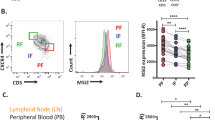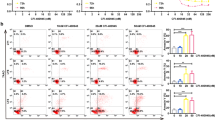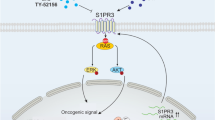Abstract
An inverse correlation between p27Kip1 expression and proliferation has been recently established in tissues derived from human lymphomas. The nucleophosmin-anaplastic lymphoma kinase (NPM–ALK)/phospholipase C-γ (PLCγ) complex also appears to play an important role in cell proliferation and malignant transformation of anaplastic large cell lymphoma (ALCL). In this study, we report that SUDHL-1 and KARPAS 299 ALCL-derived cell lines present different sensitivity to the antiproliferative effect of recombinant adenovirus-mediated p27Kip1 expression or to serum-starvation in culture media. The results indicate that exogenous p27Kip1 may interact with the NPM–ALK/PLCγ pathway in SUDHL-1 but not in KARPAS 299 cells. This interaction correlates with changes in cell cycle and cell morphology observed mainly in SUDHL-1 cells. The percentage of SUDHL-1 cells in S phase declines, whereas it is almost unchanged in KARPAS 299 cells as compared to the controls after 96 h of infection with the recombinant adenovirus. Furthermore KARPAS 299 cells are resistant to serum-starvation due to deficient p27Kip1-upregulation and G1 arrest, whereas SUDHL-1 cells respond with increased G1 phase and p27Kip1-upregulation after 48 h of serum-starvation. Both cell lines express appropriate variation of levels of cyclins E and A, and Rb-phosphorylation as expected by growing them in culture media with different FBS content. Although both cell lines express cyclin D2, SUDHL-1 cells only present high level of cyclin D3. Moreover SUDHL-1 cells express high level of PTEN and the PKB/Akt pathway is constitutively activated in both cell lines. Lastly SUDHL-1 cells show higher levels of phosphotyrosine-containing proteins that is correlated with a higher NPM–ALK-associated autophosphorylation activity compared to KARPAS 299 cells. Our study clearly identifies some of the biochemical differences that may explain the difference in sensitivity to antiproliferative stimuli shown by two cell lines derived from the same type of lymphoma.
This is a preview of subscription content, access via your institution
Access options
Subscribe to this journal
Receive 50 print issues and online access
$259.00 per year
only $5.18 per issue
Buy this article
- Purchase on Springer Link
- Instant access to full article PDF
Prices may be subject to local taxes which are calculated during checkout






Similar content being viewed by others
References
Bai R-Y, Dieter P, Peschel C, Morris SW, Duyster J . 1998 Mol. Cell. Biol. 18: 6951–6961
Bai R-Y, Ouyang T, Miething C, Morris SW, Peschel C, Duyster J . 2000 Blood 96: 4319–4327
Bischoff D, Pulford K, Mason DY, Morris SW . 1997 Mol. Cell. Biol. 17: 2312–2325
Craig C, Wresto R, Kim R, Ohri E, Li Z, Katayose D, Lee SJ, Trepel J, Cowan K, Seth P . 1997 Oncogene 14: 2283–2289
Depoortere F, Pirson I, Bartek J, Dumont JE, Roger PP . 2000 Mol. Biol. Cell 11: 1061–1076
Di Cristofano A, Pandolfi PP . 2000 Cell 100: 387–390
Falini B, Pulford K, Pucciarini A, Carbone A, De Wolf-Peeters C, Cordell J, Fizzotti M, Santucci A, Pellicci PG, Pileri S, Campo E, Ott G, Delsol G, Mason DY . 1999 Blood 94: 3509–3515
Fischer P, Nacheva E, Mason DY, Sherrington PD, Hoyle C, Hayhoe FGJ, Karpas A . 1988 Blood 72: 234–240
Gesbert F, Sellers WR, Signoretti S, Loda M, Griffin JD . 2000 J. Biol. Chem. 275: 39223–39230
Harris NL, Jaffe ES, Stein H, Banks PM, Chan JK, Cleary ML, Delsol G, De Wolf-Peeters C, Falini B, Gatter KC, Grogan TM, Isaacson PG, Knowles DM, Mason DY, Muller-Hermelink HK, Pileri SA, Ralfkiaer E, Warnke RA . 1994 Blood 84: 1361–1392
Hubinger G, Scheffrahn I, Muller E, Bai R, Duyster J, Morris SW, Schrezenmeier H, Bergmann L . 1999 Exp. Hem. 27: 1796–1805
Izuishi K, Kato K, Ogura T, Kinoshita T, Esumi H . 2000 Cancer Res. 60: 6201–6207
Jiang Y, Zhao RCH, Verfaille CM . 2000 Proc. Natl. Acad. Sci. USA 97: 10538–10543
Jonuleit T, van der Kuip H, Miething C, Michels H, Hallek M, Duyster J, Aulitzky WE . 2000 Blood 96: 1933–1939
Kuefer MU, Look AT, Pulford K, Behm FG, Pattengale PK, Mason DY, Morris SW . 1997 Blood 90: 2901–2910
Lloyd RV, Lori A, Erickson LA, Jin L, Kulig E, Qian X, Cheville JC, Scheithauer BW . 1999 Am. J. Pathol. 154: 313–323
Mason DY, Pulford KAF, Bischof D, Kuefer MU, Butler LH, Lamant L, Delsol G, Morris SW . 1998 Cancer Res. 58: 1057–1062
Morgan R, Smith SD, Hecht BK, Christy V, Mellentin JD, Warnke R, Cleary ML . 1989 Blood 73: 2155–2164
Morris SW, Kirstein MN, Valentine MB, Dittmer KG, Shapiro DN, Saltman DL, Look AT . 1994 Science 263: 1281–1284
Okuda M, Horn HF, Tarapore PJD, Bove KE, Fukasawa K . 2000 Cell 103: 127–140
Ramaswamy S, Nakamura N, Vazquez F, Batt DB, Perera S, Roberts TM, Sellers WR . 1999 Proc. Natl. Acad. Sci. USA 96: 2110–2115
Sakai A, Thieblemont C, Wellmann A, Jaffe ES, Raffeld M . 1998 Blood 92: 3410–3415
Sanchez-Beato M, Camacho FI, Martinez-Montero JC, Sol MM, Sanchez-Verde L, Villuendas R, Troncone G, Piris MA . 1997 Am. J. Pathol. 151: 151–160
Sawyers CL, Denny CT . 1994 Cell 77: 171–173
Sgambato A, Cittadini A, Faraglia B, Weinstein IB . 2000 J. Cell Physiol. 183: 18–27
Sherr JS, Roberts JM . 1995 Genes Dev. 9: 1149–1163
Sherr JS . 2000 Cancer Res. 60: 3689–3695
Spector DL, Ochs RL, Busch H . 1984 Chromosoma 90: 139–148
Stambolic V, Suzuki A, de la Pompa JL, Brothers GM, Mirtsos C, Sasaki T, Ruland J, Penninger JM, Siderovski DP, Mak TW . 1998 Cell 95: 29–39
Suzuki R, Kuroda H, Komatsu H, Hosokawa Y, Kagami Y, Ogura M, Nakamura S, Kodera Y, Morishima Y, Ueda R, Seto M . 1999 Leukemia 13: 1335–1342
Szebeni A, Olson MO . 1999 Protein Sci. 8: 905–912
Turturro F, Seth P, Link CJ . 2000a Clin. Cancer Res. 6: 185–192
Turturro F, Heineke HL, Drevyanko TF, Link Jr CJ, Seth P . 2000b Gene Ther. 7: 930–933
Turturro F, Frist A, Seth P . 2000c Mol. Ther. 1: S323
Ullrich A, Schlessinger J . 1990 Cell 61: 203–212
Wu X, Senechal K, Neshat MS, Whang YE, Sawyers CL . 1998 Proc. Natl. Acad. Sci. USA 95: 15187–15591
Acknowledgements
This work was supported by grants from Des Moines Research and Education VA Central lowa Health Care System and from Research and Innovation Center, Central lowa Health System, Des Moines, lowa, (F Turturro) and the Leukaemia Research Fund of the United Kingdom (K Pulford).
Author information
Authors and Affiliations
Rights and permissions
About this article
Cite this article
Turturro, F., Frist, A., Arnold, M. et al. Biochemical differences between SUDHL-1 and KARPAS 299 cells derived from t(2;5)-positive anaplastic large cell lymphoma are responsible for the different sensitivity to the antiproliferative effect of p27Kip1. Oncogene 20, 4466–4475 (2001). https://doi.org/10.1038/sj.onc.1204582
Received:
Revised:
Accepted:
Published:
Issue Date:
DOI: https://doi.org/10.1038/sj.onc.1204582
Keywords
This article is cited by
-
Recombinant expression, characterization, and quantification in human cancer cell lines of the Anaplastic Large-Cell Lymphoma-characteristic NPM-ALK fusion protein
Scientific Reports (2020)
-
Amplification at 7q22 targets cyclin-dependent kinase 6 in T-cell lymphoma
Leukemia (2008)
-
Genistein-induced apoptosis via Akt signaling pathway in anaplastic large-cell lymphoma
Cancer Chemotherapy and Pharmacology (2005)
-
Inhibition of JAK3 induces apoptosis and decreases anaplastic lymphoma kinase activity in anaplastic large cell lymphoma
Oncogene (2003)
-
Recombinant adenovirus-mediated cytotoxic gene therapy of lymphoproliferative disorders: is CAR important for the vector to ride?
Gene Therapy (2003)



